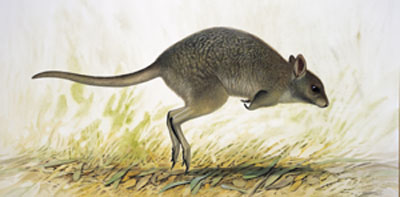
Eastern Hare-wallaby (Lagorchestes leporides)
Distribution: Southeastern Inland Australia.
Last Record: Late 1889.

This fleet and agile wallaby was once one of the most common of all marsupials on the inland plains of southeastern Australia. Its habits were rather hare-like in that by day it sat still in a well-formed ‘seat’, usually in the shelter of a tussock. If approached too closely, however, it would bound off at great speed. John Gould recorded that one animal, which had been chased by his dogs for half a kilometre ‘suddenly doubled and came back upon me…I stood perfectly still and the animal had arrived within 20 feet before it observed me, when…instead of branching off to the right or left; it bounded clear over my head.’ Another early naturalist reported that it could jump to a height of 1.8 metres, quite a feat for a hare-sized creature.
The last known specimen is a female collected by a Mr K. H. Bennett of Yandenbah, via Booligal, New South Wales. The Australian Museum had dispatched a supply of spirit and collecting materials by rail to Bennett on 23 August 1889 and the specimen was received at the museum by 4 January 1890. It was the only mammal forwarded to the museum by Bennett on this occasion, arriving with a number of birds collected in the Booligal area. It was purchased for five shillings, indicating that it was perhaps already rare.
Its final extinction is rather difficult to fathom as it occurred before the onset of intensive agriculture throughout its distribution, and before the fox became abundant. Perhaps competition with cattle and sheep, which before 1890 were present in unsustainably high numbers, or changed burning patterns, or the spread of cats, were decisive factors.